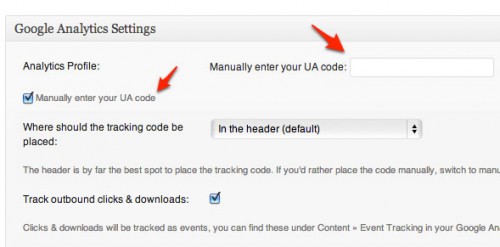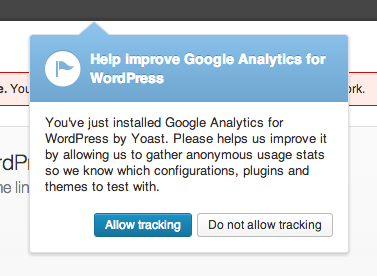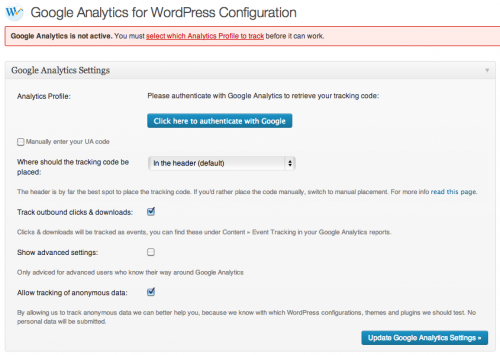As soon as you get your website, one of the things you should do is set up a program to track your website statistics. I recommend two analytics apps to help you understand your website’s traffic. One is Google Analytics and the second one is WordPress Site Stats.
We’ll cover Google Analytics on this post.
When we install a website for you, we automatically include a plugin to help you take advantage of Google Analytics. This plugin is highly rated and we recommend it and use it in all our sites. It’s also free.
How to configure the plugin
Google Analytics for WordPress by Yoast is the plugin. Until you configure this plugin and add your Google Analytics ID, and you’ll notice that your website will display an alert in red at the top of most pages, it looks like this:

Until you correct that, you won’t be able to track your statistics. Luckily, it is very easy to configure the plugin.
You will need to have a Google Analytics account setup before you can complete the plugin configuration. To get an account just visit Google Analytics and click on Create an Account.
Setting up an account there is simple but we won’t cover that step in this post. Once you get an account, you’ll need to create a new property to track. After you have your account setup and have created a property to track, you’ll be able to connect the analytics plugin to your account.
Connecting the plugin
To configure the plugin, click where it says “select which Analytics Profile to track” as shown on the screenshot above. This will take you to the main configuration screen for the Google Analytics for WordPress plugin. It looks like this:
There are two ways to plugin your account information. One is more or less automatic; use the blue button that reads Click here to authenticate with Google.
This will bring up a new screen which will ask you for permissions to use your Gmail/Google account. It will look something like this:

Select the account you want to use (the one you used to create your Google Analytics account) and continue. You can also login to a different account at this point if you want to use a different one.
After you select the account, you’ll be asked if you want to Allow access. You want to allow access to continue.
The next step will should bring you back to your website and the plugin page will have changed slightly. Instead of the big blue button that you clicked earlier, you should have a menu selector box that lets you select the Google Analytics property you created earlier.
Click on that menu and select the profile you want to use for this website. This should be all you have to do to complete the basic configuration for Google Analytics for WordPress. If all went well, click on the Update Google Analytics Settings button and you should be done. Statistics and reports will begin showing in your Google Analytics account within a few hours up to a day.
But sometimes things don’t go as planned…
Sometimes the authentication to your Google account fails. But there’s a way to configure the plugin manually. Sometimes I think it may even be easier to do it this way.
To configure the plugin manually, look for the checkbox labeled: Manually enter your UA code. It looks like this:

As soon as you click on that checkbox, you’ll get a new box where you can enter the code. The code can be found on your Google Analytics account. If you’re having trouble finding it, take a look at this support article.
Copy and paste your code into the box. Then click on the Update Google Analytics Settings button and you should be done.
One more thing
The plugin has one more box that will pop-up from time to time. It asks if you want to allow the plugin to track some usage information It looks like this:

Whether you allow tracking or not is totally up to you. The message explains it all, if you have questions about how this information is used you could ask Yoast himself. I generally allow the plugin to track this information on my websites.








Love a great step-by-step. Always helpful. Thank you, Oscar!
I’m glad you like it Sarah! hopefully it gets people past the hump of getting Google Analytics working on their site.